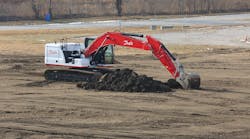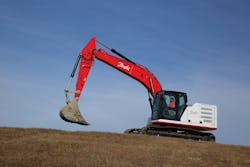Danfoss Scotland, part of Danfoss Power Solutions, has received a grant to accelerate development of technologies which will help to decarbonize excavators. The company will use the funding to validate its Dextreme Max system in a 30-ton electric excavator, which can improve hydraulic system efficiency, leading to emissions reductions.
Danfoss plans to convert a 30-ton electric excavator to demonstrate how improving the efficiency of the machine through use of the Dextreme system and other design changes can reduce energy use and thus emissions.
The Dextreme system was developed for excavators because they are the largest contributors to carbon emissions in the construction equipment industry. In an interview with Power & Motion, Leif Bruhn, head of Digital Displacement at Danfoss Power Solutions, said excavators are responsible for about 50% of emissions from construction equipment.
As the majority of machines sold and used in the market are over 10 tons, Danfoss is focusing its efforts to improve efficiency on larger machines. Tactics used on excavators could be applied to other large construction equipment as well.
How the Dextreme System Can Help Reduce Emissions
The Dextreme system, first introduced at bauma 2022 and shown at CONEXPO/IFPE 2023, is designed to reduce the energy consumption of excavators by improving hydraulic system efficiency. While powerful, hydraulics are also known to be inefficient which can hinder the overall efficiency of a machine — causing more fuel to be used and emissions produced.
Dextreme is available in three versions – Swap, Flex and Max. Each version builds upon the other to include more components and capabilities for higher levels of energy savings.
Dextreme Swap, the first commercially available and simplest version, replaces an excavator’s main hydraulic pump with a Danfoss Digital Displacement hydraulic pump (DDP1X0D), custom software and a digital controller. In the Dextreme Max system, the DDP1X0D is capable of energy recovery during excavator movements such as slew deceleration and boom lowering. By recovering energy and reducing energy losses from the hydraulics system, Danfoss estimates the system can reduce energy consumption up to 50%.
For the excavator conversion, Danfoss intends to integrate the Dextreme Max system as well as an electric drive from its Editron division and other components to create a more efficient electric excavator design. By improving the efficiency of the hydraulics system, several design and other efficiency benefits can be achieved such as:
- reduced battery capacity requirement from three to two packs
- reduced electrical load on charging infrastructure
- lower overall capital and operating expenses compared to baseline electric machine
- lower total cost of ownership compared to diesel machine
- the same or better productivity and run time than baseline machines.
Danfoss developed the Dextreme system to provide an immediate term technology for reducing carbon emissions from excavators and the construction industry as a whole.
"Electrification offers a promising route to decarbonization, but the immense power consumption of excavators means that expensive batteries and charging infrastructure are required. This cost is a major barrier to wider adoption of electric machines," said Bruhn in Danfoss' press release announcing its receipt of the grant. "By dramatically improving excavator energy efficiency, we can reduce the battery size and charging energy required to do the same amount of work. This will bring down costs, thus accelerating the transition to zero-carbon energy sources.
"The solution to a greener future in construction is efficiency. If we can prove it’s possible in excavators, we can conceivably accelerate the electrification of all large construction machinery," he said.
Decarbonizing Construction Equipment Benefits Global Efforts
Danfoss received the grant from the U.K. Government’s Department for Energy Security & Net Zero through the Red Diesel Replacement Phase 2 Competition. This program funds projects developing low-carbon alternatives to red diesel — the term for diesel fuel used in off-road vehicles — for the construction, mining, and quarrying sectors.
The off-road equipment industry is a large user of diesel and thus contributor to carbon emissions. Because of this, a larger focus is starting to be placed on finding ways to reduce diesel use and mitigate emissions. Electrification is growing in this segment but as noted by Bruhn presents several challenges. Developing technologies like the Dextreme system can help to provide more immediate term options for reducing emissions.
READ MORE: Construction Equipment Digs Deeper into Electrification
In July, Danfoss released a white paper on how decarbonization of the construction equipment industry can play a role in aiding global emissions reduction efforts. The white paper outlines the various ways in which emissions reductions can be achieved with current and future technologies, including improving the efficiency of hydraulic and other machine systems.
Programs like the Red Diesel Replacement Phase 2 Competition can help these efforts as well. Funds provided by this program aim to accelerate development of technologies that can help mitigate carbon emissions in the U.K. and global emissions. The program is conducted in two phases; the first was focused on development of component technologies during which Danfoss also received a grant and developed, as well as proved, the energy recovery capabilities of its Digital Displacement pump.
The second phase of the program is focused on system integration and demonstration of low-carbon solutions. As part of this phase, Danfoss will convert the 30-ton electric excavator at its Application Development Center in Nordborg, Denmark, beginning in January 2024. The excavator will then be shipped to and operated at a quarry in the U.K. to see how it and the Dextreme system perform in a real-world application. Project completion is planned for February 2025.
"This project is an incredible opportunity to prove the efficacy of a new system solution and architecture, demonstrating that large-scale innovation is still possible in hydraulics. We’re grateful to the U.K. Government for its support," said Jeff Herrin, senior vice president of Research, Development, and Engineering at Danfoss Power Solutions, in the company's press release. "In addition to the project’s stated goals, we intend to highlight how our application know-how and sustainable innovation is de-risking the adoption of new technology and supporting our customers in their decarbonization journeys. Transitioning to low- and zero-emission machinery isn’t just good for the environment; it can support the construction industry’s drive for lower costs and higher productivity.”
Watch our interview with Kimmo Rauma, vice president of Danfoss' Editron division, to learn how the company was able to achieve hydraulic system efficiency improvements when converting a wheel loader to a battery-electric power system.




